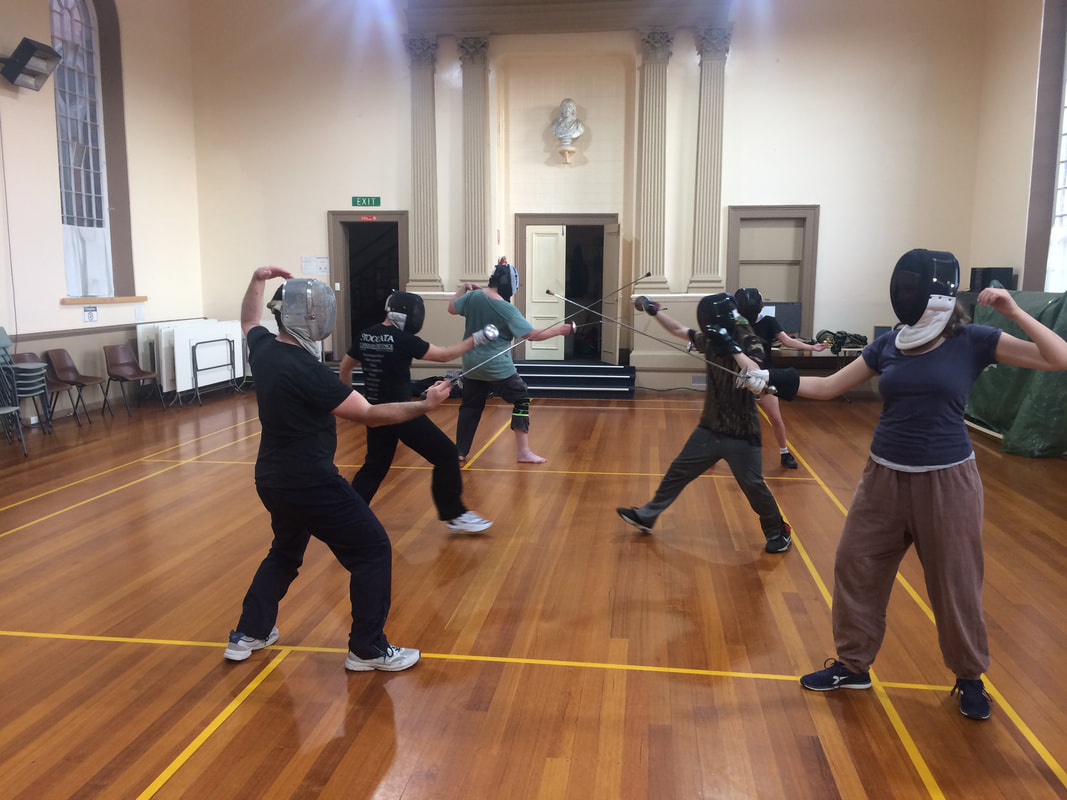
What is HEMA?
HEMA stands for Historical European Martial Arts, or in other words, the martial arts that were practiced by Europeans and European descended countries, like Australia and the US, before those arts were turned into sports in the 19th and 20th centuries. It is sometimes referred to as Historical Fencing (HF) or Western Martial Arts (WMA), but HEMA is the most commonly used acronym.
Many people are surprised to hear western combat arts referred to as martial arts, but in fact, the term martial art is European. It refers to the Arts of Mars, the Roman god of war and was first used in the mid-16th century.
We know how our ancestors fought, because they left us a huge corpus of fencing manuals dating from around 1300 (the earliest manuscript is undated, so we’re not 100% sure when it was written). The instructors at T.A.S. have spent decades deciphering a number of historical fencing manuals and reconstructing the fighting styles described in them. What we have found is that from the earliest manuals, what they describe are sophisticated combat systems, utilizing all of the basic principles found in modern weapon arts, including modern fencing.
So, HEMA is an umbrella term for a large number of different martial arts, using a wide variety of weapons, some of which we teach at T.A.S., some we don’t. We approach these arts as martial arts, not specifically as a sport. Our rules are written to allow us to fence as closely as possible to the styles described in the manuals we use. While we compete in tournaments (Founder Stephen Hand is the first Australian to win an international HEMA tournament, his son Lewis was the inaugural junior champion in the revived World Broadsword Championship and Usher Shaun Douglas placed fourth in the latest World Broadsword Championship in 2025) our focus is on fencing as the people who wrote the manuals fenced.
Most of the focus of T.A.S. is on swordsmanship. Swords were far from the most effective melee weapons that existed, but they have a flexibility that allows for extremely sophisticated encounters. In addition, swords can easily be blunted and tipped for safety, without changing the way they handle.
Not being a re-enactment club we don't wear period clothing or armour. We wear modern protective equipment to ensure safety while training as realistically as possible. This includes gear like fencing masks, gloves, padded jackets, elbow and knee guards all made from puncture-resistant materials. Some weapons require more specific gear to bout with safely.
Contrary to many movie depictions, historical European combat methods and equipment are not crude, heavy or clumsy.
HEMA is a activity for those interested in history, skillful movement, developing poise and self-control while making friends along the way to excellence.
HEMA stands for Historical European Martial Arts, or in other words, the martial arts that were practiced by Europeans and European descended countries, like Australia and the US, before those arts were turned into sports in the 19th and 20th centuries. It is sometimes referred to as Historical Fencing (HF) or Western Martial Arts (WMA), but HEMA is the most commonly used acronym.
Many people are surprised to hear western combat arts referred to as martial arts, but in fact, the term martial art is European. It refers to the Arts of Mars, the Roman god of war and was first used in the mid-16th century.
We know how our ancestors fought, because they left us a huge corpus of fencing manuals dating from around 1300 (the earliest manuscript is undated, so we’re not 100% sure when it was written). The instructors at T.A.S. have spent decades deciphering a number of historical fencing manuals and reconstructing the fighting styles described in them. What we have found is that from the earliest manuals, what they describe are sophisticated combat systems, utilizing all of the basic principles found in modern weapon arts, including modern fencing.
So, HEMA is an umbrella term for a large number of different martial arts, using a wide variety of weapons, some of which we teach at T.A.S., some we don’t. We approach these arts as martial arts, not specifically as a sport. Our rules are written to allow us to fence as closely as possible to the styles described in the manuals we use. While we compete in tournaments (Founder Stephen Hand is the first Australian to win an international HEMA tournament, his son Lewis was the inaugural junior champion in the revived World Broadsword Championship and Usher Shaun Douglas placed fourth in the latest World Broadsword Championship in 2025) our focus is on fencing as the people who wrote the manuals fenced.
Most of the focus of T.A.S. is on swordsmanship. Swords were far from the most effective melee weapons that existed, but they have a flexibility that allows for extremely sophisticated encounters. In addition, swords can easily be blunted and tipped for safety, without changing the way they handle.
Not being a re-enactment club we don't wear period clothing or armour. We wear modern protective equipment to ensure safety while training as realistically as possible. This includes gear like fencing masks, gloves, padded jackets, elbow and knee guards all made from puncture-resistant materials. Some weapons require more specific gear to bout with safely.
Contrary to many movie depictions, historical European combat methods and equipment are not crude, heavy or clumsy.
HEMA is a activity for those interested in history, skillful movement, developing poise and self-control while making friends along the way to excellence.
